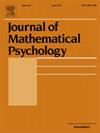Cognitive models of decision-making with identifiable parameters: Diffusion decision models with within-trial noise
IF 1.5
4区 心理学
Q2 MATHEMATICS, INTERDISCIPLINARY APPLICATIONS
引用次数: 0
Abstract
Diffusion Decision Models (DDMs) are a widely used class of models that assume an accumulation of evidence during a quick decision. These models are often used as measurement models to assess individual differences in cognitive processes such as evidence accumulation rate and response caution. An underlying assumption of these models is that there is internal noise in the evidence accumulation process. We argue that this internal noise is a relevant psychological construct that is likely to vary over participants and explain differences in cognitive ability. In some cases a change in noise is a more parsimonious explanation of joint changes in speed-accuracy tradeoffs and ability. However, fitting traditional DDMs to behavioral data cannot yield estimates of an individual’s evidence accumulation rate, caution, and internal noise at the same time. This is due to an intrinsic unidentifiability of these parameters in DDMs. We explored the practical consequences of this unidentifiability by estimating the Bayesian joint posterior distributions of parameters (and thus joint uncertainty) for simulated data. We also introduce methods of estimating these parameters. Fundamentally, these parameters can be identified in two ways: (1) We can assume that one of the three parameters is fixed to a constant. We show that fixing one parameter, as is typical in fitting DDMs, results in parameter estimates that are ratios of true cognitive parameters including the parameter that is fixed. By fixing another parameter instead of noise, different ratios are estimated, which may be useful for measuring individual differences. (2) Alternatively, we could use additional observed variables that we can reasonably assume to be related to model parameters. Electroencephalographic (EEG) data or single-unit activity from animals can yield candidate measures. We show parameter recovery for models with true (simulated) connections to such additional covariates, as well as some recovery in misspecified models. We evaluate this approach with both single-trial and participant-level additional observed variables. Our findings reveal that with the integration of additional data, it becomes possible to discern individual differences across all parameters, enhancing the utility of DDMs without relying on strong assumptions. However, there are some important caveats with these new modeling approaches, and we provide recommendations for their use. This research paves the way to use the deeper theoretical understanding of sequential sampling models and the new modeling methods to measure individual differences in internal noise during decision-making.
具有可识别参数的决策认知模型:带有试验内噪声的扩散决策模型
扩散决策模型(DDMs)是一类广泛使用的模型,它假设在快速决策过程中积累证据。这些模型通常被用作评估个体在证据积累率和反应谨慎性等认知过程中的差异的测量模型。这些模型的一个基本假设是,在证据积累过程中存在内部噪声。我们认为,这种内部噪音是一种相关的心理结构,可能会因参与者而异,并解释认知能力的差异。在某些情况下,噪音的变化是速度-精度权衡和能力共同变化的更简洁的解释。然而,将传统的ddm拟合到行为数据中不能同时产生对个人证据积累率、谨慎性和内部噪声的估计。这是由于ddm中这些参数的内在不可识别性。我们通过估计模拟数据参数的贝叶斯联合后验分布(因此联合不确定性)来探索这种不可识别性的实际后果。我们还介绍了估计这些参数的方法。基本上,这些参数可以用两种方式识别:(1)我们可以假设三个参数中的一个固定为常数。我们表明,固定一个参数,正如在拟合ddm中典型的那样,结果是参数估计是真实认知参数的比率,包括固定的参数。通过固定另一个参数而不是噪声,可以估计出不同的比率,这可能有助于测量个体差异。(2)或者,我们可以使用额外的观测变量,我们可以合理地假设这些变量与模型参数有关。脑电图(EEG)数据或来自动物的单单位活动可以产生候选测量。我们展示了与这些附加协变量具有真实(模拟)连接的模型的参数恢复,以及在错误指定的模型中的一些恢复。我们用单试验和参与者水平的附加观察变量来评估这种方法。我们的研究结果表明,通过整合其他数据,可以识别所有参数之间的个体差异,从而在不依赖于强假设的情况下增强ddm的效用。然而,这些新的建模方法有一些重要的注意事项,我们为它们的使用提供了一些建议。本研究为利用序贯抽样模型的更深入的理论认识和新的建模方法来衡量决策过程中内部噪声的个体差异铺平了道路。
本文章由计算机程序翻译,如有差异,请以英文原文为准。
求助全文
约1分钟内获得全文
求助全文
来源期刊

Journal of Mathematical Psychology
医学-数学跨学科应用
CiteScore
3.70
自引率
11.10%
发文量
37
审稿时长
20.2 weeks
期刊介绍:
The Journal of Mathematical Psychology includes articles, monographs and reviews, notes and commentaries, and book reviews in all areas of mathematical psychology. Empirical and theoretical contributions are equally welcome.
Areas of special interest include, but are not limited to, fundamental measurement and psychological process models, such as those based upon neural network or information processing concepts. A partial listing of substantive areas covered include sensation and perception, psychophysics, learning and memory, problem solving, judgment and decision-making, and motivation.
The Journal of Mathematical Psychology is affiliated with the Society for Mathematical Psychology.
Research Areas include:
• Models for sensation and perception, learning, memory and thinking
• Fundamental measurement and scaling
• Decision making
• Neural modeling and networks
• Psychophysics and signal detection
• Neuropsychological theories
• Psycholinguistics
• Motivational dynamics
• Animal behavior
• Psychometric theory
 求助内容:
求助内容: 应助结果提醒方式:
应助结果提醒方式:


